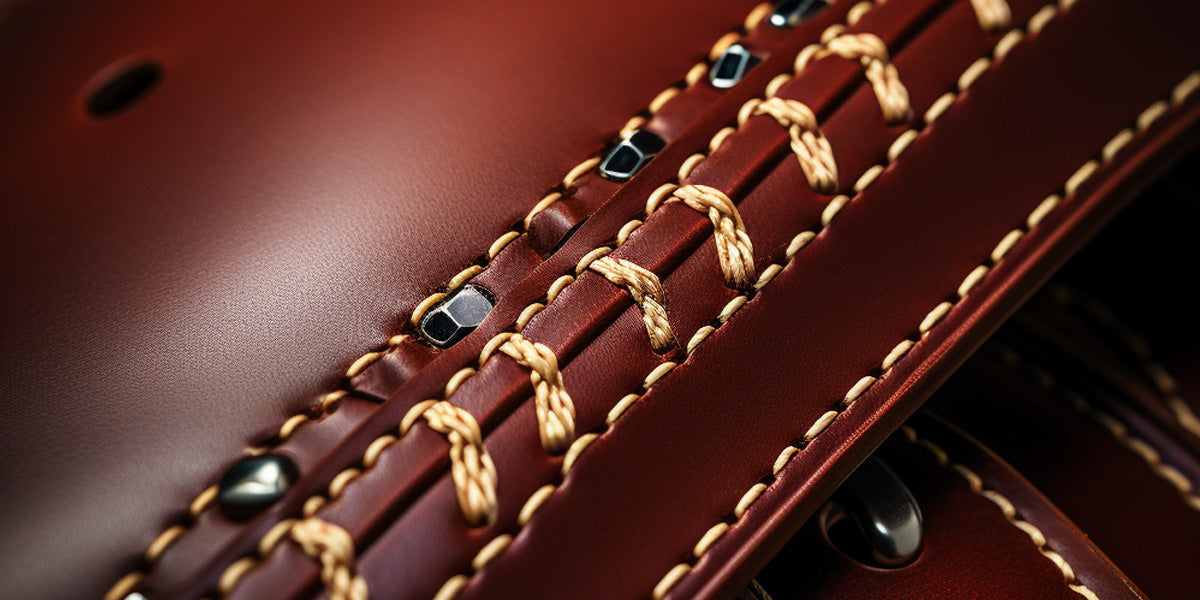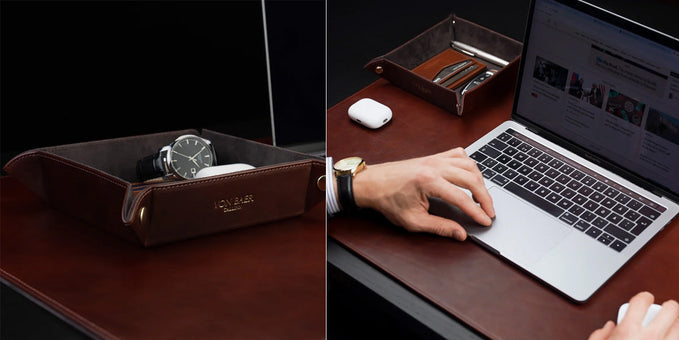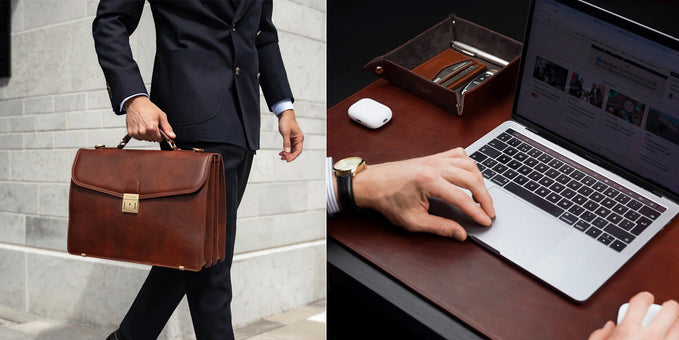How To Sew Leather By Hand (Saddle Stitching)

Leather is one-of-a-kind; it has a distinct personality.
People use it in everything from apparel and bookbinding to bags and wallets.
If you want to work with leather, learning to hand sew is a good place to start.
Hand stitching is a valuable technique in leatherwork that is relatively easy to learn with some practice.
Here's our full guide to hand-stitching leather:
What You'll Need

You’ll need the following tools to stitch leather by hand:
- Leather: Prepare your pieces of leather. A softer/thinner piece is easier if this is your first time sewing.
- Needles: Proper leather needles feature a triangular point that readily pierces through leather compared to standard sewing needles.
- Strong Thread: Use a strong thread such as waxed linen or nylon for use with leather.
- Awl: This is used to make holes in leather.
- Overstitch Wheel: This tool aids in the placement of your stitches.
- Thimble: This will help to protect your fingers, ideal for hand stitching.
- Straight Edge/Ruler: Use this to draw straight lines for your stitches.
Preparing to Sew

Prepare your leather and tools before you start sewing:
- Mark a Straight Stitch Line: Using a ruler or straight edge, mark a straight line where you want your stitches to be. This will assist you in maintaining nice and even stitches.
- Punch Your Holes: Make holes along your stitch line using an awl or a leather punch. It would be best if you spaced the holes evenly. An overstitch wheel can help you mark even stitch intervals.
- Thread Your Needle Without Tying: Cut a length of thread approximately four times your stitch line’s length. Thread your needle without tying the end of the thread. Instead, make use of a saddle stitch, which requires a needle at both thread ends.
Performing The Saddle Stitch

The saddle stitch is a robust, long-lasting stitch commonly employed in leatherwork. Here’s how to go about it:
- Thread Insertion and Alignment: Insert one needle into the first hole and pull the thread through until it is even on both sides. One needle should now be on each side of the leather.
- Dual Needle Insertion: Insert the needle from the rear side into the next hole, then insert the needle from the front into the same hole. Tighten both ends of the thread. This procedure should be repeated for each hole along your stitch line.
- Backstitching and Security: Backstitch to secure the thread when you reach the end of your stitch line. Sew over the last few stitches, then snip the thread close to the leather.
Leather Sewing Tips

- Always practice your stitches on a scrap piece of leather. This will give you a sense of how the material will behave before beginning your actual project.
- Avoid pulling your stitches too tight, which can cause the leather to warp. However, if your stitches are too slack, they will not properly hold the leather together.
- Always cover the point while not using your awl to avoid accidents.
- Sewing through leather can be difficult. If you’re having problems, try pulling the needle through with a pair of pliers.
- If you’re dealing with a particularly thick piece of leather, a sewing pony or clamp might assist you in keeping the leather in place while you sew.
Troubleshooting Typical Issues
You may run into certain issues when you sew leather. Here are some pointers to help you handle them:
- Thread Breakage: If your thread is constantly breaking, it may need to be more robust for the leather you work with. Change to a stronger thread, such as waxed linen or nylon.
- Uneven Stitches: If your stitches are uneven, use an overstitch wheel to mark even intervals between your stitches. Maintain consistency in the tension you apply to the thread as you stitch.
Hand-stitching leather can be challenging at first, but you’ll get the hang of it as you practice.
It’s a crucial ability that can open many doors for DIY projects and hobbies.
So get some leather and have fun sewing!
Related articles:
- Repair cat scratches on leather
- Remove water stains from leather
- Clean leather wallet & remove stains/smells
- Remove ink from leather
- Get smell out of leather
- Remove stains from leather shoes
- Clean suede leather bag
- How to reform a leather bag
- How to maintain leather bags
- Repair cracked leather
- Wet leather
- How to clean leather bag
- How to restore faded leather bag
How to Care for Your Leather Items

Once you’ve sewed your leather item, it’s critical to care for it properly to make it last:
- Clean: Use a moist towel and a mild leather cleaner to clean your leather products. Harsh chemicals should be avoided as they can harm the leather.
- Condition: To maintain the leather nice and supple, use a leather conditioner every few months. We recommend this Premium Leather Cream.
- Storing: Keep your leather items in a cool, dry location away from direct sunlight. Stuff a leather bag or pocketbook with bubble wrap or tissue paper to help it hold its shape while being stored.
Related articles:
- How to stretch leather
- How to shrink leather
- How to soften leather
- How to wash leather
- How to fix faux leather peeling
- Bonded Leather Peeling
- Bleach On Leather
- How To Fix Scuffed Leather
- How To Rehydrate Leather
- How To Stiffen Leather
- How To Restore Leather
- How To Dye Leather
- How To Get Wrinkles Out Of Leather
- How To Clean Leather
- How To Clean Leather Purse
- Leather
- Leather grades
Conclusion
We hope you enjoyed our article on stitching leather.
If you have any questions or comments, contact us at info@vonbaer.com, or leave them in the comments.
Want to read more? Check out our Leather pages.

Author: Albert Varkki
Albert Varkki is the co-founder of Von Baer. He understands leather products as a consumer, supplier, and a manufacturer, helping you with the inside knowledge you need, to choose the perfect leather product for you.
We strive for the highest editorial standards, and to only publish accurate information on our website.
Leave a Comment
Your email address will not be published.






